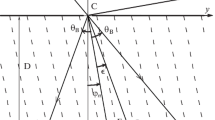Summary
The 14.4 keV (λ=0.8602 Å)γ-rays from a57Co source were scattered by the (444) and (555) planes of a perfect silicon crystal and the inelastic contribution to the total scattering was determined by means of the Mössbauer effect. It was found that the thermal diffuse scattering has intensity maxima under the Bragg peak, as expected on the basis of the lattice wave theory of the X-ray diffuse scattering. The ratio between the integrated intensities of the thermal diffuse and the total scatterings was equal to 0.47 and 0.55 for the (444) and (555) reflections respectively, the geometry of the experiment being similar to those commonly used for studies of diffuse scattering. The integrated Bragg intensities of the above reflections were compared with those calculated by using the formulae of the dynamical theory of diffraction. A comparison was also made between the intensities of the thermal scattering at the Bragg angle and those calculated by using some simplifying assumptions for the numerical evaluation of the formulae of the theory. A satisfactory agreement between experimental and calculated values was found for both the Bragg and the thermal diffuse scatterings.
Riassunto
Mediante l’effetto Mössbauer si è determinato il contributo anelastico allo scattering della radiazioneγ di 14.4 keV (λ=0.8602 Å) diffratta dai piani (444) e (555) di un cristallo perfetto di silicio. Come previsto dalla teoria dello scattering dei raggi X dalle vibrazioni reticolari, si è trovato che i massimi di intensità dello scattering anelastico coincidono con le posizioni di Bragg. In una geometria di diffrazione simile a quella usata comunemente per studiare lo scattering termico, si è trovato un rapporto fra l’intensità integrata di quest’ultimo e quella dello scattering totale pari a 0.47 ed a 0.55 per le riflessioni (444) e (555) rispettivamente. Le intensità integrate dello scattering di Bragg sono state confrontate con quelle calcolate per mezzo della teoria dinamica della diffrazione; le intensità dello scattering termico in posizione di Bragg sono state confrontate con quelle calcolate mediante alcune ipotesi semplificative. In entrambi i casi si è trovato un accordo soddisfacente fra i valori sperimentali e quelli teorici.
Реэюме
γ-лучи с знергией 14.4 кзВ (λ=0.8602 Å) от источника57Co рассеивались плоскостями (444) и (555) в идеальном кристалле кремния, и определялся неупругий вклад в полное рассеяние с помошью зффекта Мëссбаузра. Было обнаружено, что тепловое диффуэное рассеяние имеет максимальную интенсивность в пике Брзгга, как и ожидалось на основе рещеточной вплновой теории диффуэного рассеяния Х-лучей. Отнощение между проинтегрированными интенсивностями теплового диффуэного и полного рассеяния составило 0.47 и 0.55 для отражения от плоскостей (444) и (555), соответственно, причем, геометрия зксперимента является аналогичной обычно испольэуемым геометриям при иэучении диффуэного рассеяния. Проинтегрированные интенсивности Брзгга для выщеупомянутых отражений сравнивались с вычисленными с испольэованием формул динамической теории диффракции. Также проводилось сравнение между интенсивностями теплового рассеяния на угол Брзгга и интенсивностями, вычисленными с испольэованием некоторых упрошаюших предположений для численных оценок формул теории. Получается удовлетворительное согласие между зкспериментальными и вычисленными величинами и для рассеяния Брзгга и для теплового диффуэного рассеяния.
Similar content being viewed by others
References
R. W. James:The Optical Principles of the Diffraction of X-Rays (London, 1954).
D. A. O’Connor andN. M. Butt:Phys. Lett.,7, 233 (1963).
N. M. Butt andD. A. O’Connor:Proc. Phys. Soc.,90, 247 (1967).
S. Margulies andJ. R. Ehrman:Nucl. Instr. and Meth.,12, 131 (1961).
A. J. Freeman:Acta Cryst.,12, 929 (1959).
A. Merlini andE. van der Voort: inStudy of Lattice and Electronic Defects in Crystalline Solids, Euratom Report 1643.e (1964).
D. R. Chipman andB. W. Battermann:Journ. Appl. Phys.,34, 912 (1963).
P. B. Hirsch andG. N. Ramachandran:Acta Crystal.,3, 187 (1950).
International Tables for X-Ray Crystallography, vol.3 (Birmingham, 1962).
B. W. Battermann andD. R. Chipman:Phys. Rev.,126, 1461 (1962).
B. N. Brockhouse:Phys. Rev. Lett.,6, 256 (1959).
O. L. Anderson:Physical Acoustics, vol.3, part B (New York, 1965), p. 87.
Author information
Authors and Affiliations
Rights and permissions
About this article
Cite this article
Ghezzi, C., Merlini, A. & Pace, S. Determination of the thermal diffuse scattering in a silicon crystal by means of the Mössbauer effect. Nuovo Cimento B (1965-1970) 64, 103–116 (1969). https://doi.org/10.1007/BF02710285
Received:
Published:
Issue Date:
DOI: https://doi.org/10.1007/BF02710285




